Detailed Content Analysis: IT Service Management and ITIL Framework
VerifiedAdded on 2022/11/26
|20
|4410
|139
Report
AI Summary
This report provides a comprehensive content analysis of IT Service Management (ITSM), focusing on the ITIL framework and its core components. It explores the ITSM model, service lifecycle phases (strategy, design, transition, operation, and continual service improvement), and crucial concepts like governance, risk management, and business relationship management. The report delves into financial management, demand management, capacity management, and IT service continuity management. Furthermore, it examines key processes within service operation, including event, incident, and problem management, as well as the application of the Deming Cycle for continuous improvement. The analysis covers the four balances of service operation and the role of business relationship management in fostering customer satisfaction. This detailed overview provides a strong foundation for understanding and implementing effective IT service management practices.
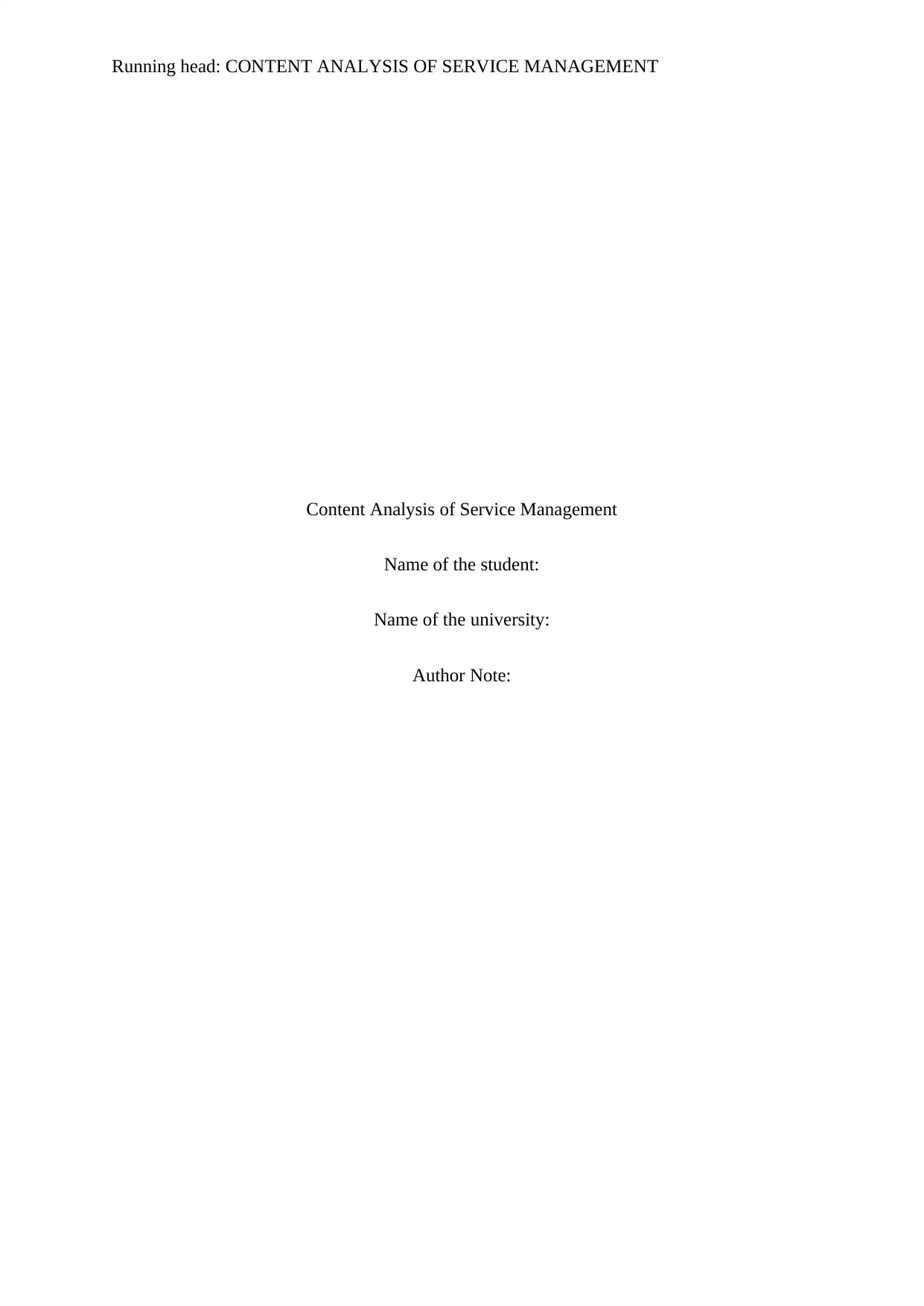
Running head: CONTENT ANALYSIS OF SERVICE MANAGEMENT
Content Analysis of Service Management
Name of the student:
Name of the university:
Author Note:
Content Analysis of Service Management
Name of the student:
Name of the university:
Author Note:
Paraphrase This Document
Need a fresh take? Get an instant paraphrase of this document with our AI Paraphraser
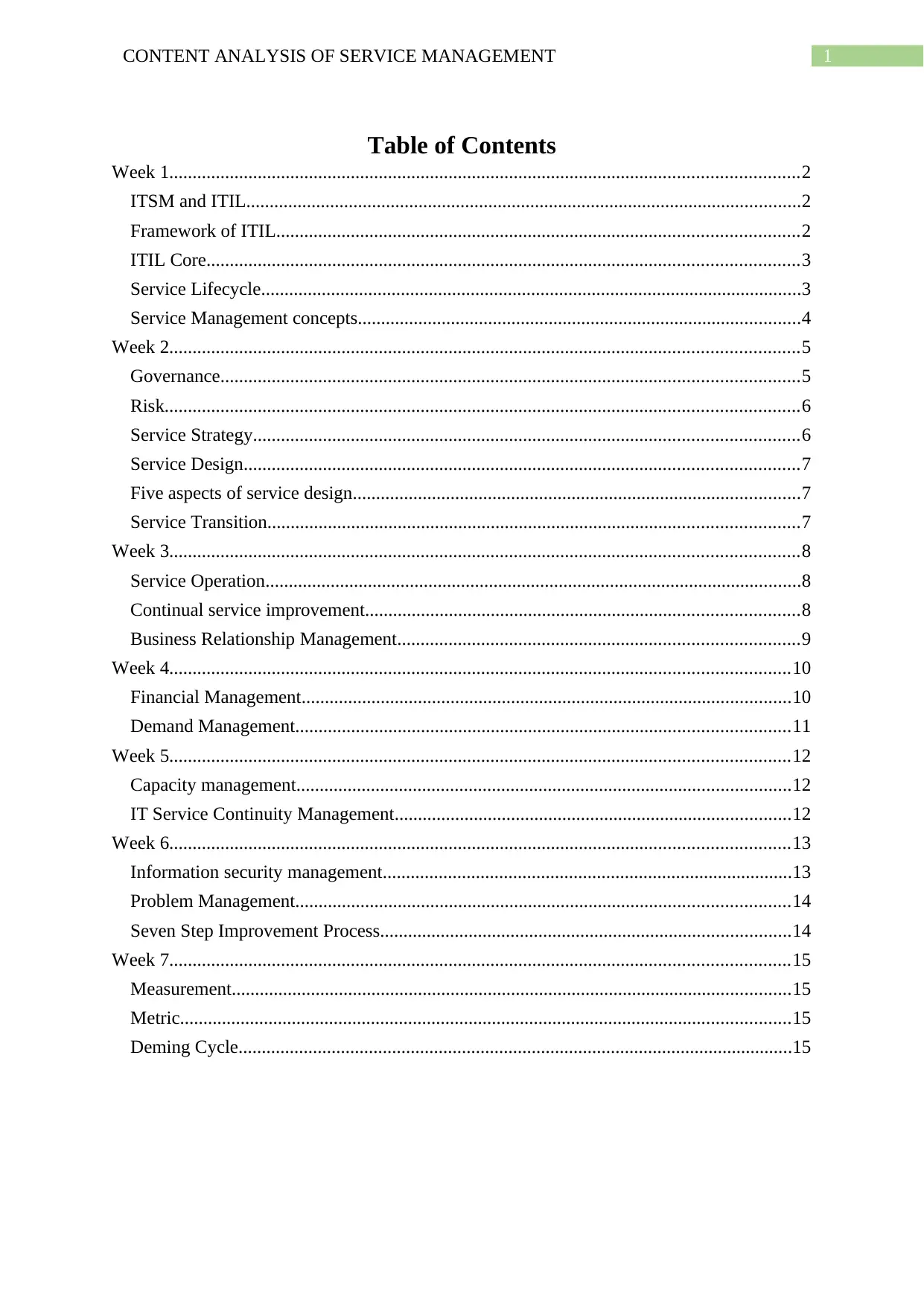
1CONTENT ANALYSIS OF SERVICE MANAGEMENT
Table of Contents
Week 1.......................................................................................................................................2
ITSM and ITIL.......................................................................................................................2
Framework of ITIL................................................................................................................2
ITIL Core...............................................................................................................................3
Service Lifecycle....................................................................................................................3
Service Management concepts...............................................................................................4
Week 2.......................................................................................................................................5
Governance............................................................................................................................5
Risk........................................................................................................................................6
Service Strategy.....................................................................................................................6
Service Design.......................................................................................................................7
Five aspects of service design................................................................................................7
Service Transition..................................................................................................................7
Week 3.......................................................................................................................................8
Service Operation...................................................................................................................8
Continual service improvement.............................................................................................8
Business Relationship Management......................................................................................9
Week 4.....................................................................................................................................10
Financial Management.........................................................................................................10
Demand Management..........................................................................................................11
Week 5.....................................................................................................................................12
Capacity management..........................................................................................................12
IT Service Continuity Management.....................................................................................12
Week 6.....................................................................................................................................13
Information security management........................................................................................13
Problem Management..........................................................................................................14
Seven Step Improvement Process........................................................................................14
Week 7.....................................................................................................................................15
Measurement........................................................................................................................15
Metric...................................................................................................................................15
Deming Cycle.......................................................................................................................15
Table of Contents
Week 1.......................................................................................................................................2
ITSM and ITIL.......................................................................................................................2
Framework of ITIL................................................................................................................2
ITIL Core...............................................................................................................................3
Service Lifecycle....................................................................................................................3
Service Management concepts...............................................................................................4
Week 2.......................................................................................................................................5
Governance............................................................................................................................5
Risk........................................................................................................................................6
Service Strategy.....................................................................................................................6
Service Design.......................................................................................................................7
Five aspects of service design................................................................................................7
Service Transition..................................................................................................................7
Week 3.......................................................................................................................................8
Service Operation...................................................................................................................8
Continual service improvement.............................................................................................8
Business Relationship Management......................................................................................9
Week 4.....................................................................................................................................10
Financial Management.........................................................................................................10
Demand Management..........................................................................................................11
Week 5.....................................................................................................................................12
Capacity management..........................................................................................................12
IT Service Continuity Management.....................................................................................12
Week 6.....................................................................................................................................13
Information security management........................................................................................13
Problem Management..........................................................................................................14
Seven Step Improvement Process........................................................................................14
Week 7.....................................................................................................................................15
Measurement........................................................................................................................15
Metric...................................................................................................................................15
Deming Cycle.......................................................................................................................15
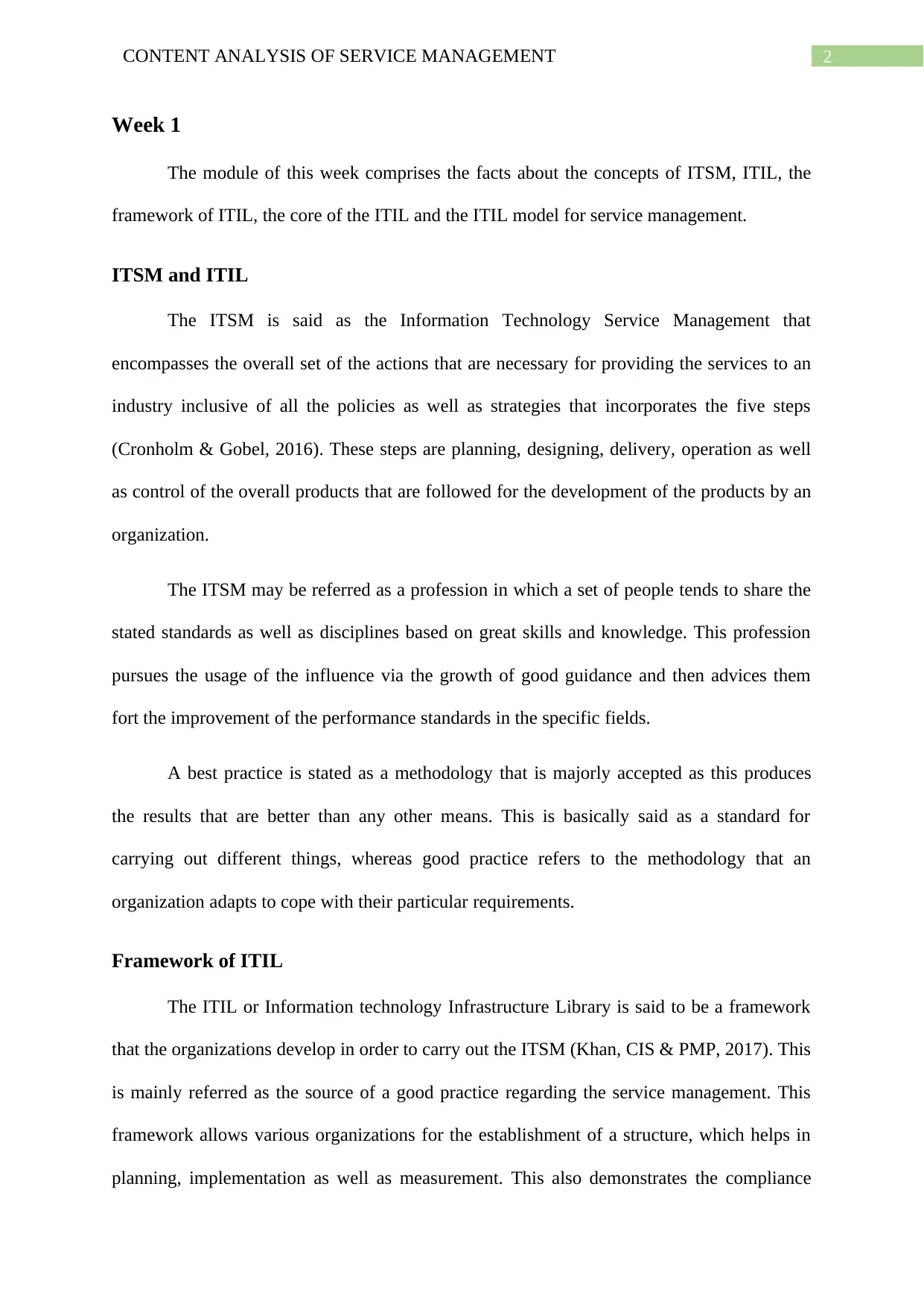
2CONTENT ANALYSIS OF SERVICE MANAGEMENT
Week 1
The module of this week comprises the facts about the concepts of ITSM, ITIL, the
framework of ITIL, the core of the ITIL and the ITIL model for service management.
ITSM and ITIL
The ITSM is said as the Information Technology Service Management that
encompasses the overall set of the actions that are necessary for providing the services to an
industry inclusive of all the policies as well as strategies that incorporates the five steps
(Cronholm & Gobel, 2016). These steps are planning, designing, delivery, operation as well
as control of the overall products that are followed for the development of the products by an
organization.
The ITSM may be referred as a profession in which a set of people tends to share the
stated standards as well as disciplines based on great skills and knowledge. This profession
pursues the usage of the influence via the growth of good guidance and then advices them
fort the improvement of the performance standards in the specific fields.
A best practice is stated as a methodology that is majorly accepted as this produces
the results that are better than any other means. This is basically said as a standard for
carrying out different things, whereas good practice refers to the methodology that an
organization adapts to cope with their particular requirements.
Framework of ITIL
The ITIL or Information technology Infrastructure Library is said to be a framework
that the organizations develop in order to carry out the ITSM (Khan, CIS & PMP, 2017). This
is mainly referred as the source of a good practice regarding the service management. This
framework allows various organizations for the establishment of a structure, which helps in
planning, implementation as well as measurement. This also demonstrates the compliance
Week 1
The module of this week comprises the facts about the concepts of ITSM, ITIL, the
framework of ITIL, the core of the ITIL and the ITIL model for service management.
ITSM and ITIL
The ITSM is said as the Information Technology Service Management that
encompasses the overall set of the actions that are necessary for providing the services to an
industry inclusive of all the policies as well as strategies that incorporates the five steps
(Cronholm & Gobel, 2016). These steps are planning, designing, delivery, operation as well
as control of the overall products that are followed for the development of the products by an
organization.
The ITSM may be referred as a profession in which a set of people tends to share the
stated standards as well as disciplines based on great skills and knowledge. This profession
pursues the usage of the influence via the growth of good guidance and then advices them
fort the improvement of the performance standards in the specific fields.
A best practice is stated as a methodology that is majorly accepted as this produces
the results that are better than any other means. This is basically said as a standard for
carrying out different things, whereas good practice refers to the methodology that an
organization adapts to cope with their particular requirements.
Framework of ITIL
The ITIL or Information technology Infrastructure Library is said to be a framework
that the organizations develop in order to carry out the ITSM (Khan, CIS & PMP, 2017). This
is mainly referred as the source of a good practice regarding the service management. This
framework allows various organizations for the establishment of a structure, which helps in
planning, implementation as well as measurement. This also demonstrates the compliance
⊘ This is a preview!⊘
Do you want full access?
Subscribe today to unlock all pages.

Trusted by 1+ million students worldwide
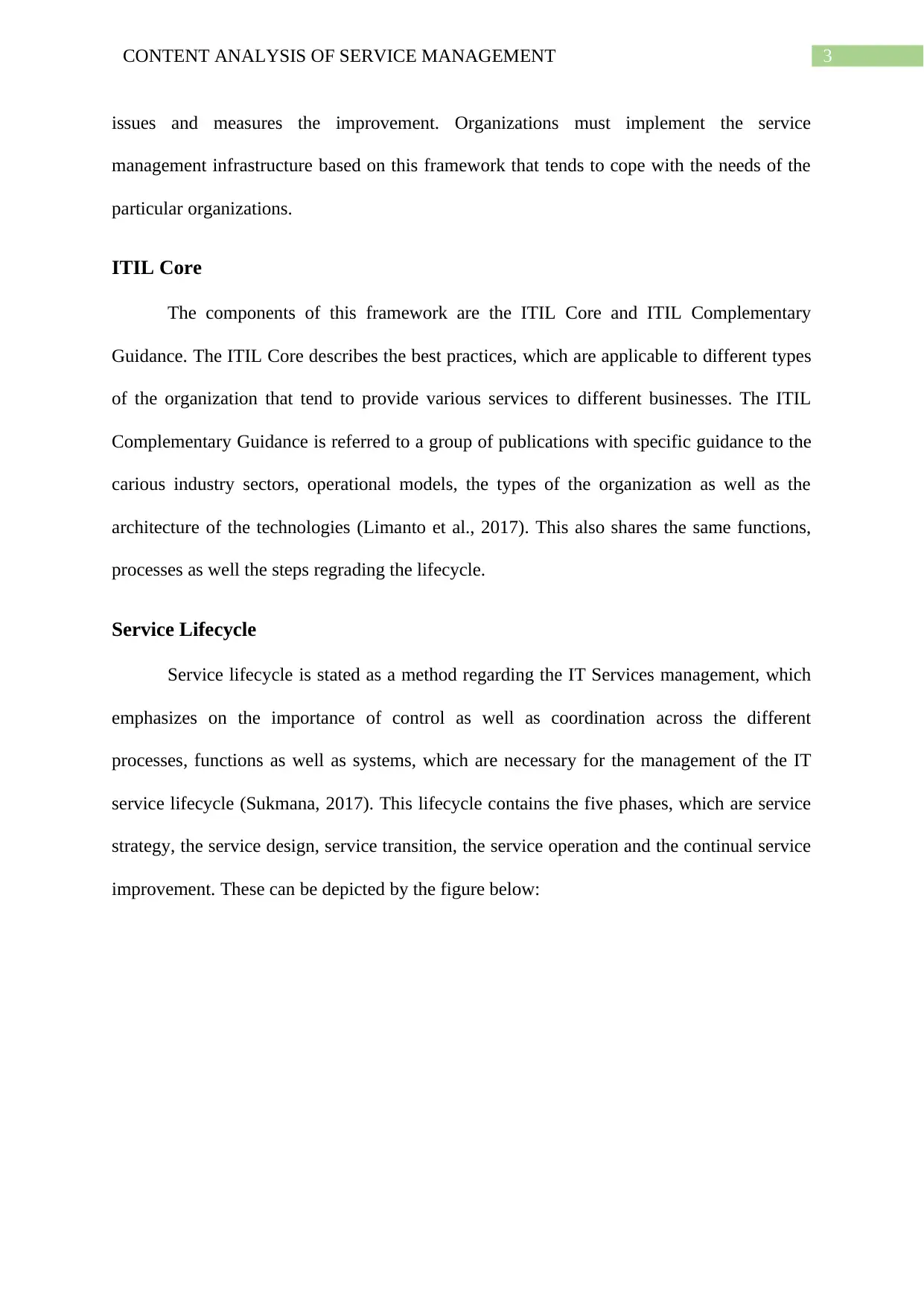
3CONTENT ANALYSIS OF SERVICE MANAGEMENT
issues and measures the improvement. Organizations must implement the service
management infrastructure based on this framework that tends to cope with the needs of the
particular organizations.
ITIL Core
The components of this framework are the ITIL Core and ITIL Complementary
Guidance. The ITIL Core describes the best practices, which are applicable to different types
of the organization that tend to provide various services to different businesses. The ITIL
Complementary Guidance is referred to a group of publications with specific guidance to the
carious industry sectors, operational models, the types of the organization as well as the
architecture of the technologies (Limanto et al., 2017). This also shares the same functions,
processes as well the steps regrading the lifecycle.
Service Lifecycle
Service lifecycle is stated as a method regarding the IT Services management, which
emphasizes on the importance of control as well as coordination across the different
processes, functions as well as systems, which are necessary for the management of the IT
service lifecycle (Sukmana, 2017). This lifecycle contains the five phases, which are service
strategy, the service design, service transition, the service operation and the continual service
improvement. These can be depicted by the figure below:
issues and measures the improvement. Organizations must implement the service
management infrastructure based on this framework that tends to cope with the needs of the
particular organizations.
ITIL Core
The components of this framework are the ITIL Core and ITIL Complementary
Guidance. The ITIL Core describes the best practices, which are applicable to different types
of the organization that tend to provide various services to different businesses. The ITIL
Complementary Guidance is referred to a group of publications with specific guidance to the
carious industry sectors, operational models, the types of the organization as well as the
architecture of the technologies (Limanto et al., 2017). This also shares the same functions,
processes as well the steps regrading the lifecycle.
Service Lifecycle
Service lifecycle is stated as a method regarding the IT Services management, which
emphasizes on the importance of control as well as coordination across the different
processes, functions as well as systems, which are necessary for the management of the IT
service lifecycle (Sukmana, 2017). This lifecycle contains the five phases, which are service
strategy, the service design, service transition, the service operation and the continual service
improvement. These can be depicted by the figure below:
Paraphrase This Document
Need a fresh take? Get an instant paraphrase of this document with our AI Paraphraser
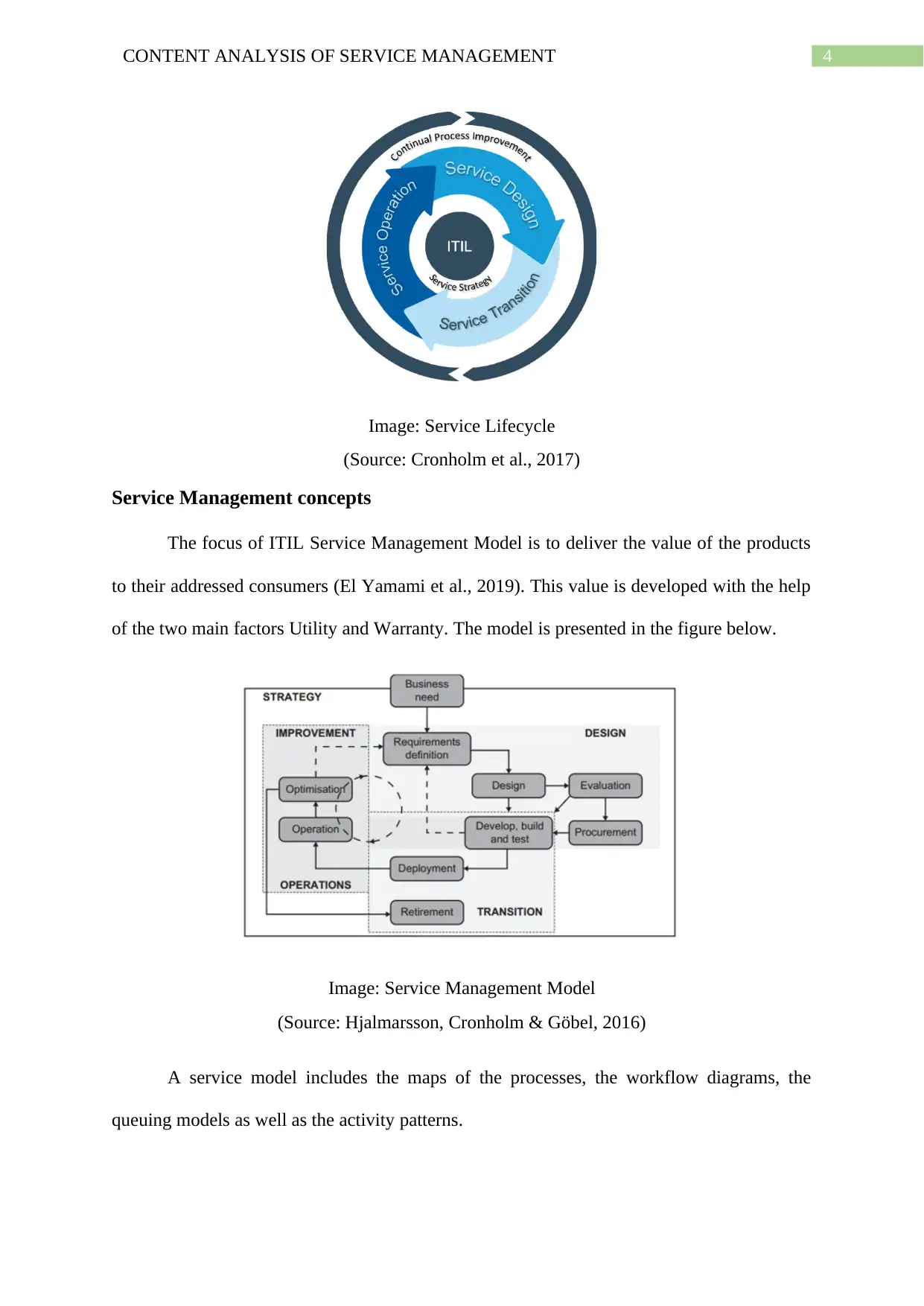
4CONTENT ANALYSIS OF SERVICE MANAGEMENT
Image: Service Lifecycle
(Source: Cronholm et al., 2017)
Service Management concepts
The focus of ITIL Service Management Model is to deliver the value of the products
to their addressed consumers (El Yamami et al., 2019). This value is developed with the help
of the two main factors Utility and Warranty. The model is presented in the figure below.
Image: Service Management Model
(Source: Hjalmarsson, Cronholm & Göbel, 2016)
A service model includes the maps of the processes, the workflow diagrams, the
queuing models as well as the activity patterns.
Image: Service Lifecycle
(Source: Cronholm et al., 2017)
Service Management concepts
The focus of ITIL Service Management Model is to deliver the value of the products
to their addressed consumers (El Yamami et al., 2019). This value is developed with the help
of the two main factors Utility and Warranty. The model is presented in the figure below.
Image: Service Management Model
(Source: Hjalmarsson, Cronholm & Göbel, 2016)
A service model includes the maps of the processes, the workflow diagrams, the
queuing models as well as the activity patterns.
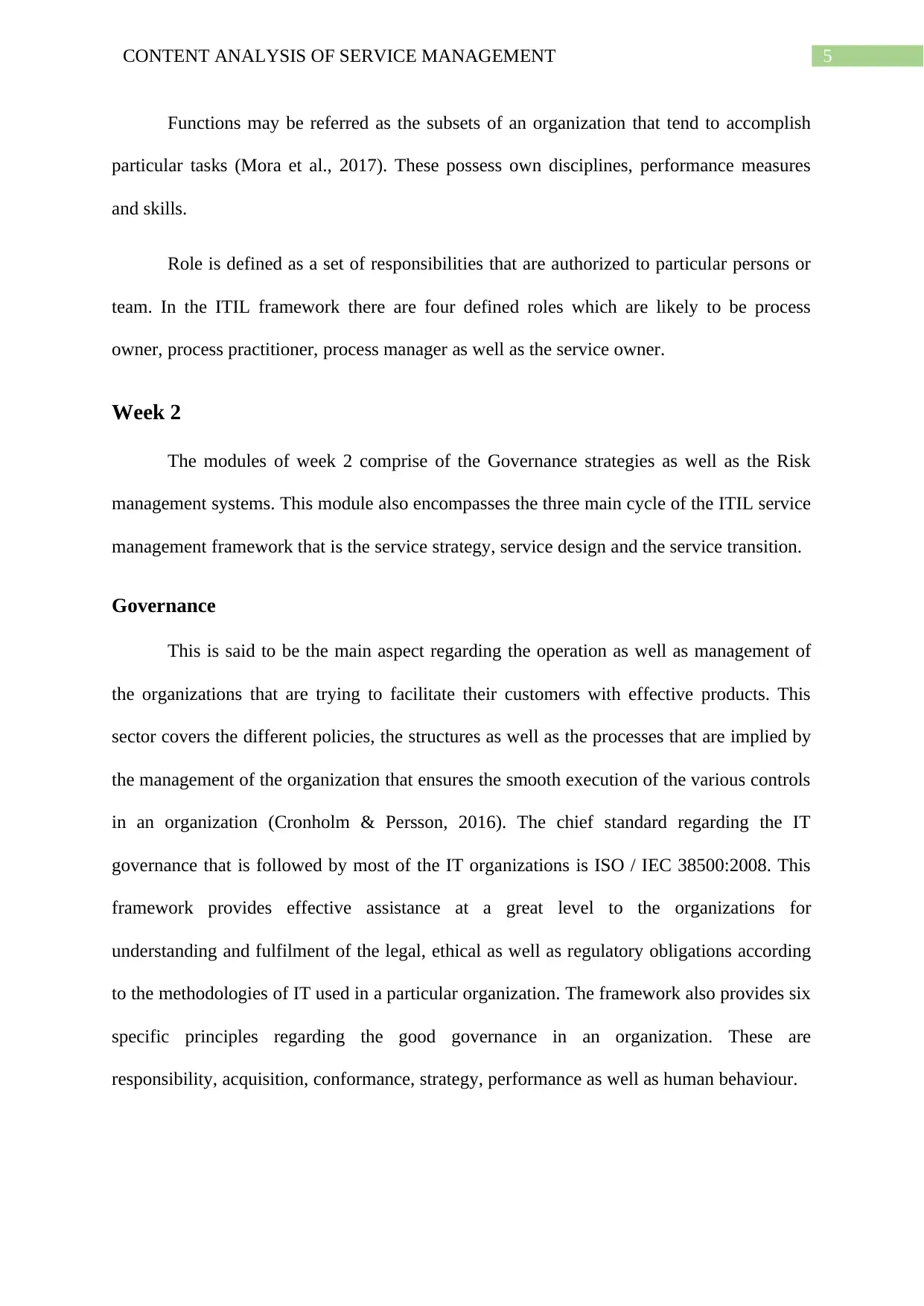
5CONTENT ANALYSIS OF SERVICE MANAGEMENT
Functions may be referred as the subsets of an organization that tend to accomplish
particular tasks (Mora et al., 2017). These possess own disciplines, performance measures
and skills.
Role is defined as a set of responsibilities that are authorized to particular persons or
team. In the ITIL framework there are four defined roles which are likely to be process
owner, process practitioner, process manager as well as the service owner.
Week 2
The modules of week 2 comprise of the Governance strategies as well as the Risk
management systems. This module also encompasses the three main cycle of the ITIL service
management framework that is the service strategy, service design and the service transition.
Governance
This is said to be the main aspect regarding the operation as well as management of
the organizations that are trying to facilitate their customers with effective products. This
sector covers the different policies, the structures as well as the processes that are implied by
the management of the organization that ensures the smooth execution of the various controls
in an organization (Cronholm & Persson, 2016). The chief standard regarding the IT
governance that is followed by most of the IT organizations is ISO / IEC 38500:2008. This
framework provides effective assistance at a great level to the organizations for
understanding and fulfilment of the legal, ethical as well as regulatory obligations according
to the methodologies of IT used in a particular organization. The framework also provides six
specific principles regarding the good governance in an organization. These are
responsibility, acquisition, conformance, strategy, performance as well as human behaviour.
Functions may be referred as the subsets of an organization that tend to accomplish
particular tasks (Mora et al., 2017). These possess own disciplines, performance measures
and skills.
Role is defined as a set of responsibilities that are authorized to particular persons or
team. In the ITIL framework there are four defined roles which are likely to be process
owner, process practitioner, process manager as well as the service owner.
Week 2
The modules of week 2 comprise of the Governance strategies as well as the Risk
management systems. This module also encompasses the three main cycle of the ITIL service
management framework that is the service strategy, service design and the service transition.
Governance
This is said to be the main aspect regarding the operation as well as management of
the organizations that are trying to facilitate their customers with effective products. This
sector covers the different policies, the structures as well as the processes that are implied by
the management of the organization that ensures the smooth execution of the various controls
in an organization (Cronholm & Persson, 2016). The chief standard regarding the IT
governance that is followed by most of the IT organizations is ISO / IEC 38500:2008. This
framework provides effective assistance at a great level to the organizations for
understanding and fulfilment of the legal, ethical as well as regulatory obligations according
to the methodologies of IT used in a particular organization. The framework also provides six
specific principles regarding the good governance in an organization. These are
responsibility, acquisition, conformance, strategy, performance as well as human behaviour.
⊘ This is a preview!⊘
Do you want full access?
Subscribe today to unlock all pages.

Trusted by 1+ million students worldwide
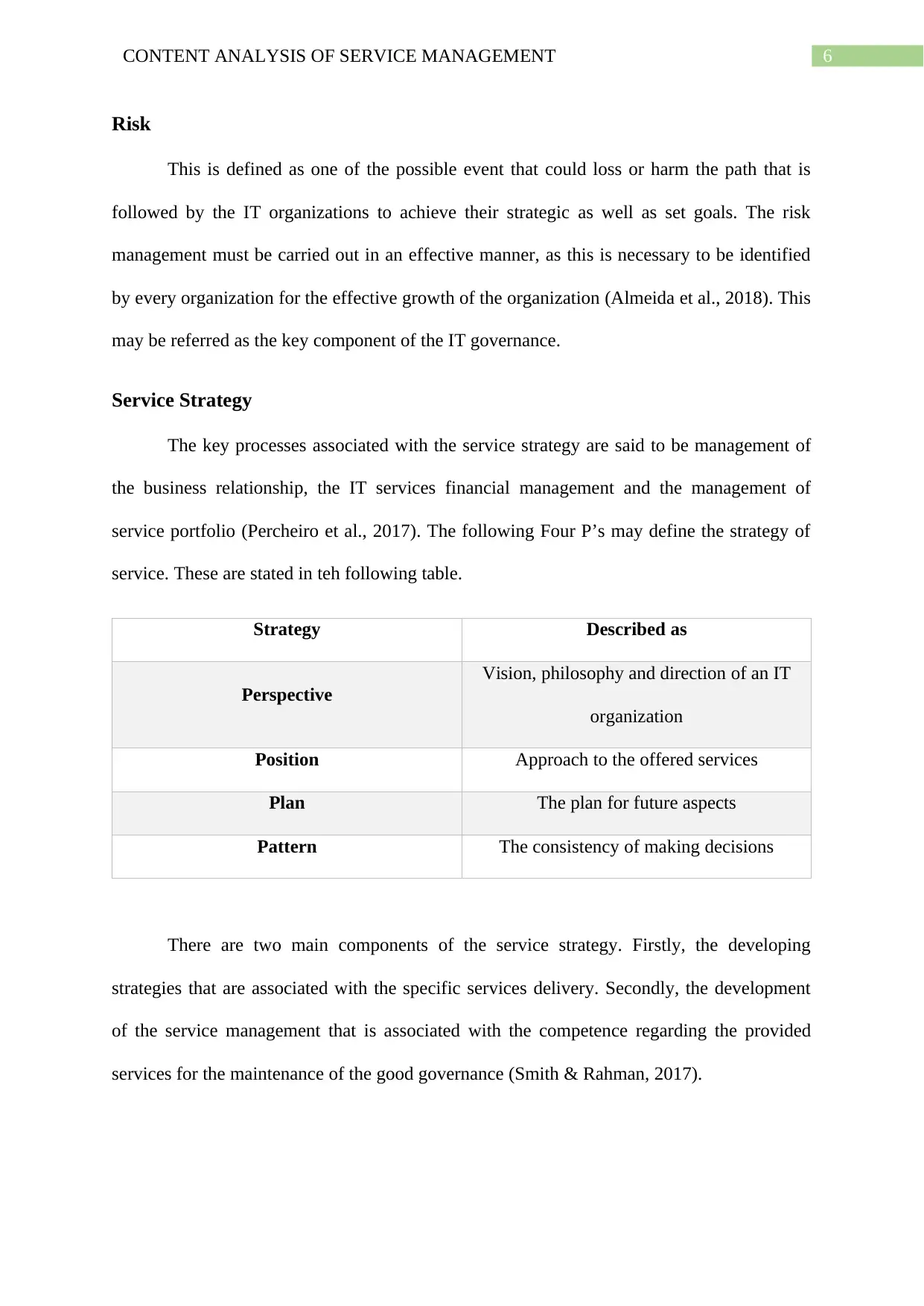
6CONTENT ANALYSIS OF SERVICE MANAGEMENT
Risk
This is defined as one of the possible event that could loss or harm the path that is
followed by the IT organizations to achieve their strategic as well as set goals. The risk
management must be carried out in an effective manner, as this is necessary to be identified
by every organization for the effective growth of the organization (Almeida et al., 2018). This
may be referred as the key component of the IT governance.
Service Strategy
The key processes associated with the service strategy are said to be management of
the business relationship, the IT services financial management and the management of
service portfolio (Percheiro et al., 2017). The following Four P’s may define the strategy of
service. These are stated in teh following table.
Strategy Described as
Perspective
Vision, philosophy and direction of an IT
organization
Position Approach to the offered services
Plan The plan for future aspects
Pattern The consistency of making decisions
There are two main components of the service strategy. Firstly, the developing
strategies that are associated with the specific services delivery. Secondly, the development
of the service management that is associated with the competence regarding the provided
services for the maintenance of the good governance (Smith & Rahman, 2017).
Risk
This is defined as one of the possible event that could loss or harm the path that is
followed by the IT organizations to achieve their strategic as well as set goals. The risk
management must be carried out in an effective manner, as this is necessary to be identified
by every organization for the effective growth of the organization (Almeida et al., 2018). This
may be referred as the key component of the IT governance.
Service Strategy
The key processes associated with the service strategy are said to be management of
the business relationship, the IT services financial management and the management of
service portfolio (Percheiro et al., 2017). The following Four P’s may define the strategy of
service. These are stated in teh following table.
Strategy Described as
Perspective
Vision, philosophy and direction of an IT
organization
Position Approach to the offered services
Plan The plan for future aspects
Pattern The consistency of making decisions
There are two main components of the service strategy. Firstly, the developing
strategies that are associated with the specific services delivery. Secondly, the development
of the service management that is associated with the competence regarding the provided
services for the maintenance of the good governance (Smith & Rahman, 2017).
Paraphrase This Document
Need a fresh take? Get an instant paraphrase of this document with our AI Paraphraser
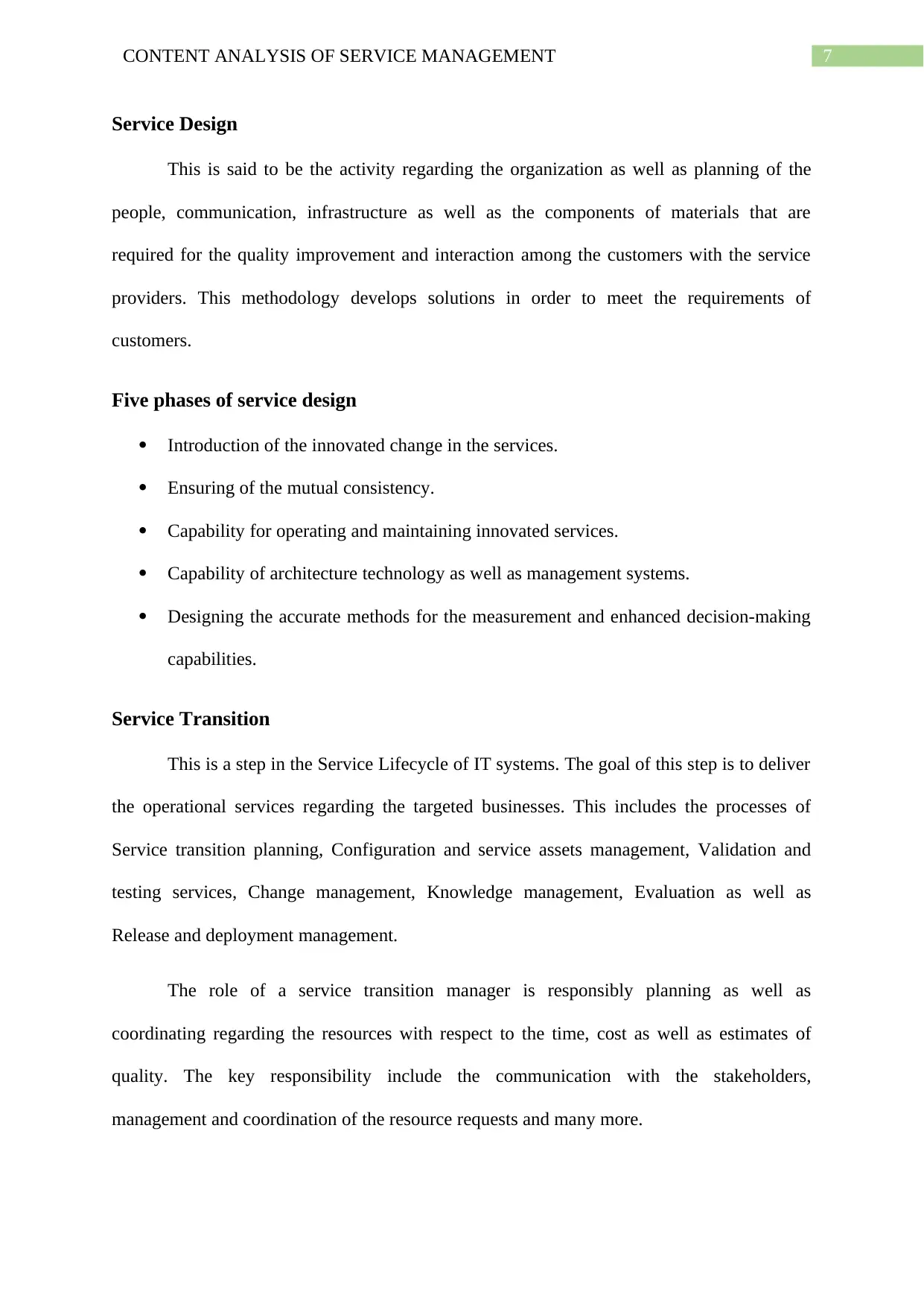
7CONTENT ANALYSIS OF SERVICE MANAGEMENT
Service Design
This is said to be the activity regarding the organization as well as planning of the
people, communication, infrastructure as well as the components of materials that are
required for the quality improvement and interaction among the customers with the service
providers. This methodology develops solutions in order to meet the requirements of
customers.
Five phases of service design
Introduction of the innovated change in the services.
Ensuring of the mutual consistency.
Capability for operating and maintaining innovated services.
Capability of architecture technology as well as management systems.
Designing the accurate methods for the measurement and enhanced decision-making
capabilities.
Service Transition
This is a step in the Service Lifecycle of IT systems. The goal of this step is to deliver
the operational services regarding the targeted businesses. This includes the processes of
Service transition planning, Configuration and service assets management, Validation and
testing services, Change management, Knowledge management, Evaluation as well as
Release and deployment management.
The role of a service transition manager is responsibly planning as well as
coordinating regarding the resources with respect to the time, cost as well as estimates of
quality. The key responsibility include the communication with the stakeholders,
management and coordination of the resource requests and many more.
Service Design
This is said to be the activity regarding the organization as well as planning of the
people, communication, infrastructure as well as the components of materials that are
required for the quality improvement and interaction among the customers with the service
providers. This methodology develops solutions in order to meet the requirements of
customers.
Five phases of service design
Introduction of the innovated change in the services.
Ensuring of the mutual consistency.
Capability for operating and maintaining innovated services.
Capability of architecture technology as well as management systems.
Designing the accurate methods for the measurement and enhanced decision-making
capabilities.
Service Transition
This is a step in the Service Lifecycle of IT systems. The goal of this step is to deliver
the operational services regarding the targeted businesses. This includes the processes of
Service transition planning, Configuration and service assets management, Validation and
testing services, Change management, Knowledge management, Evaluation as well as
Release and deployment management.
The role of a service transition manager is responsibly planning as well as
coordinating regarding the resources with respect to the time, cost as well as estimates of
quality. The key responsibility include the communication with the stakeholders,
management and coordination of the resource requests and many more.
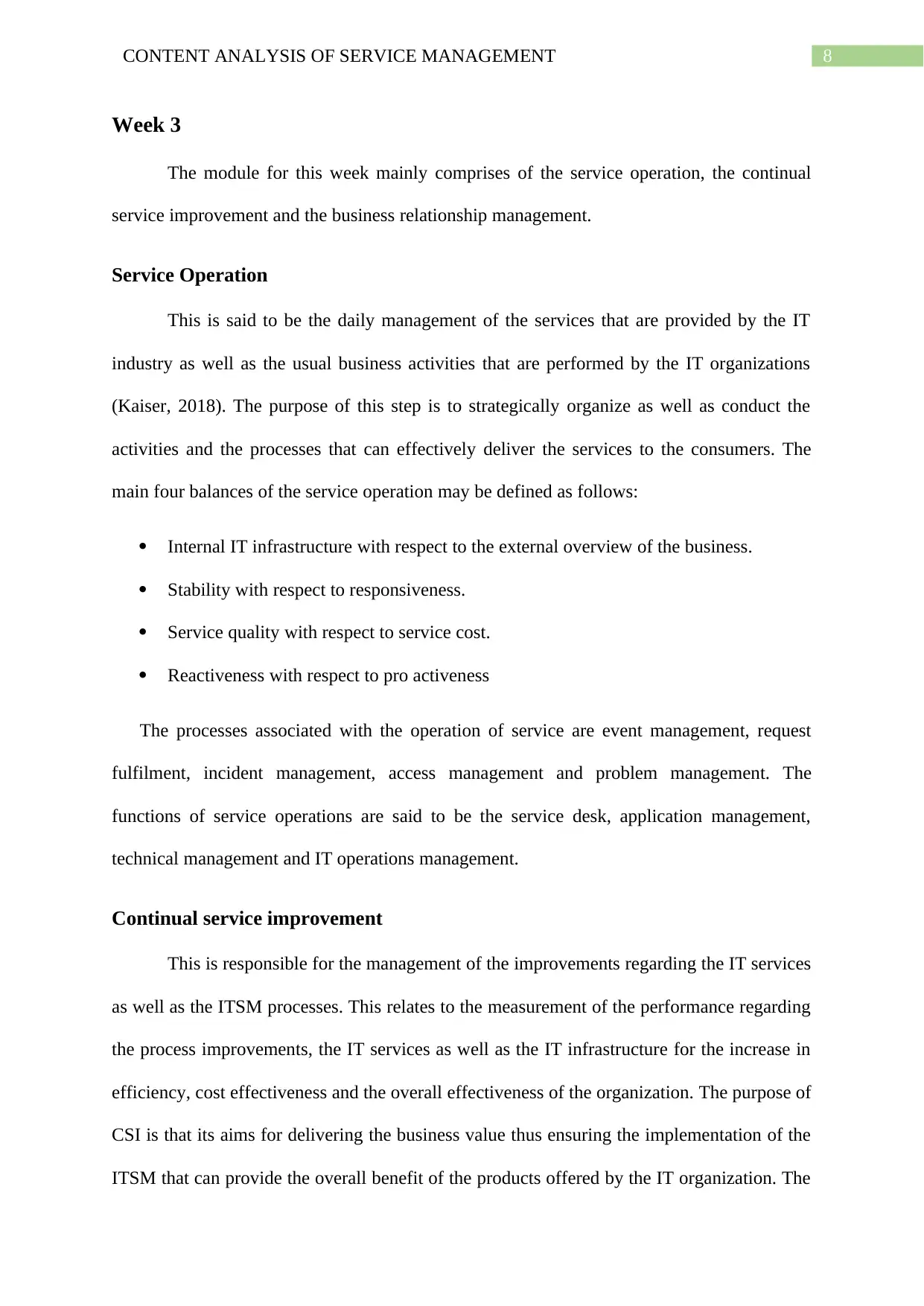
8CONTENT ANALYSIS OF SERVICE MANAGEMENT
Week 3
The module for this week mainly comprises of the service operation, the continual
service improvement and the business relationship management.
Service Operation
This is said to be the daily management of the services that are provided by the IT
industry as well as the usual business activities that are performed by the IT organizations
(Kaiser, 2018). The purpose of this step is to strategically organize as well as conduct the
activities and the processes that can effectively deliver the services to the consumers. The
main four balances of the service operation may be defined as follows:
Internal IT infrastructure with respect to the external overview of the business.
Stability with respect to responsiveness.
Service quality with respect to service cost.
Reactiveness with respect to pro activeness
The processes associated with the operation of service are event management, request
fulfilment, incident management, access management and problem management. The
functions of service operations are said to be the service desk, application management,
technical management and IT operations management.
Continual service improvement
This is responsible for the management of the improvements regarding the IT services
as well as the ITSM processes. This relates to the measurement of the performance regarding
the process improvements, the IT services as well as the IT infrastructure for the increase in
efficiency, cost effectiveness and the overall effectiveness of the organization. The purpose of
CSI is that its aims for delivering the business value thus ensuring the implementation of the
ITSM that can provide the overall benefit of the products offered by the IT organization. The
Week 3
The module for this week mainly comprises of the service operation, the continual
service improvement and the business relationship management.
Service Operation
This is said to be the daily management of the services that are provided by the IT
industry as well as the usual business activities that are performed by the IT organizations
(Kaiser, 2018). The purpose of this step is to strategically organize as well as conduct the
activities and the processes that can effectively deliver the services to the consumers. The
main four balances of the service operation may be defined as follows:
Internal IT infrastructure with respect to the external overview of the business.
Stability with respect to responsiveness.
Service quality with respect to service cost.
Reactiveness with respect to pro activeness
The processes associated with the operation of service are event management, request
fulfilment, incident management, access management and problem management. The
functions of service operations are said to be the service desk, application management,
technical management and IT operations management.
Continual service improvement
This is responsible for the management of the improvements regarding the IT services
as well as the ITSM processes. This relates to the measurement of the performance regarding
the process improvements, the IT services as well as the IT infrastructure for the increase in
efficiency, cost effectiveness and the overall effectiveness of the organization. The purpose of
CSI is that its aims for delivering the business value thus ensuring the implementation of the
ITSM that can provide the overall benefit of the products offered by the IT organization. The
⊘ This is a preview!⊘
Do you want full access?
Subscribe today to unlock all pages.

Trusted by 1+ million students worldwide
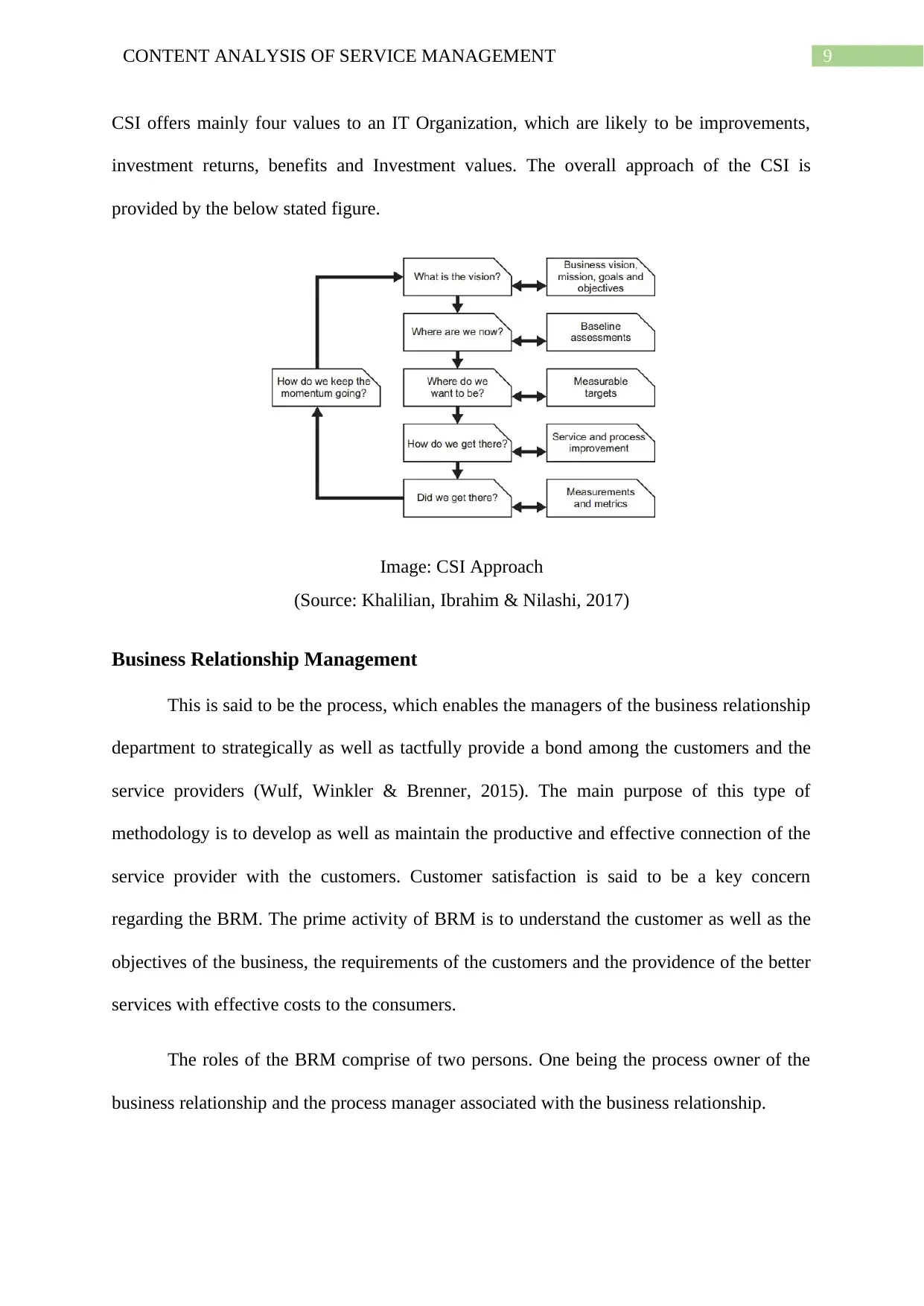
9CONTENT ANALYSIS OF SERVICE MANAGEMENT
CSI offers mainly four values to an IT Organization, which are likely to be improvements,
investment returns, benefits and Investment values. The overall approach of the CSI is
provided by the below stated figure.
Image: CSI Approach
(Source: Khalilian, Ibrahim & Nilashi, 2017)
Business Relationship Management
This is said to be the process, which enables the managers of the business relationship
department to strategically as well as tactfully provide a bond among the customers and the
service providers (Wulf, Winkler & Brenner, 2015). The main purpose of this type of
methodology is to develop as well as maintain the productive and effective connection of the
service provider with the customers. Customer satisfaction is said to be a key concern
regarding the BRM. The prime activity of BRM is to understand the customer as well as the
objectives of the business, the requirements of the customers and the providence of the better
services with effective costs to the consumers.
The roles of the BRM comprise of two persons. One being the process owner of the
business relationship and the process manager associated with the business relationship.
CSI offers mainly four values to an IT Organization, which are likely to be improvements,
investment returns, benefits and Investment values. The overall approach of the CSI is
provided by the below stated figure.
Image: CSI Approach
(Source: Khalilian, Ibrahim & Nilashi, 2017)
Business Relationship Management
This is said to be the process, which enables the managers of the business relationship
department to strategically as well as tactfully provide a bond among the customers and the
service providers (Wulf, Winkler & Brenner, 2015). The main purpose of this type of
methodology is to develop as well as maintain the productive and effective connection of the
service provider with the customers. Customer satisfaction is said to be a key concern
regarding the BRM. The prime activity of BRM is to understand the customer as well as the
objectives of the business, the requirements of the customers and the providence of the better
services with effective costs to the consumers.
The roles of the BRM comprise of two persons. One being the process owner of the
business relationship and the process manager associated with the business relationship.
Paraphrase This Document
Need a fresh take? Get an instant paraphrase of this document with our AI Paraphraser
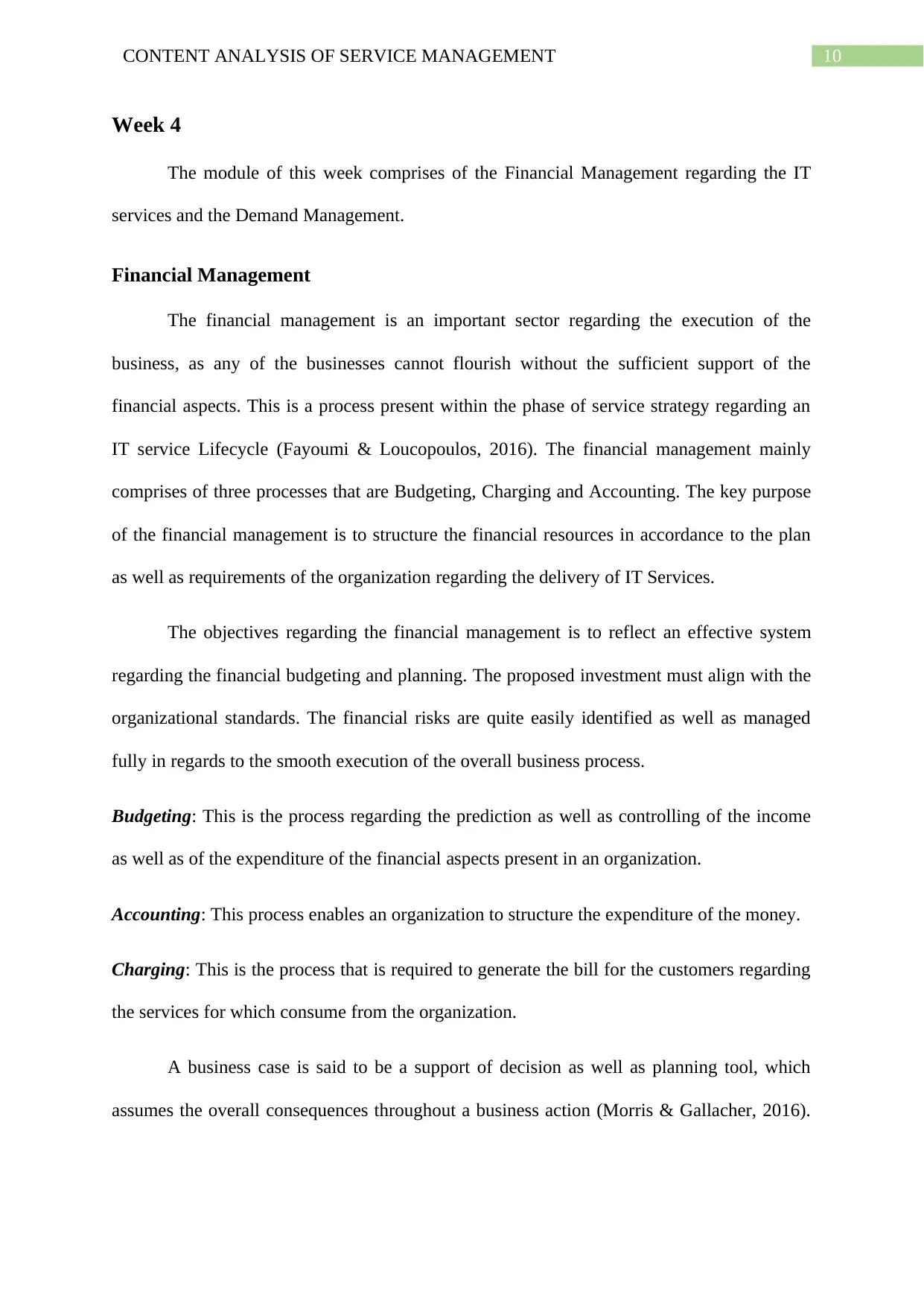
10CONTENT ANALYSIS OF SERVICE MANAGEMENT
Week 4
The module of this week comprises of the Financial Management regarding the IT
services and the Demand Management.
Financial Management
The financial management is an important sector regarding the execution of the
business, as any of the businesses cannot flourish without the sufficient support of the
financial aspects. This is a process present within the phase of service strategy regarding an
IT service Lifecycle (Fayoumi & Loucopoulos, 2016). The financial management mainly
comprises of three processes that are Budgeting, Charging and Accounting. The key purpose
of the financial management is to structure the financial resources in accordance to the plan
as well as requirements of the organization regarding the delivery of IT Services.
The objectives regarding the financial management is to reflect an effective system
regarding the financial budgeting and planning. The proposed investment must align with the
organizational standards. The financial risks are quite easily identified as well as managed
fully in regards to the smooth execution of the overall business process.
Budgeting: This is the process regarding the prediction as well as controlling of the income
as well as of the expenditure of the financial aspects present in an organization.
Accounting: This process enables an organization to structure the expenditure of the money.
Charging: This is the process that is required to generate the bill for the customers regarding
the services for which consume from the organization.
A business case is said to be a support of decision as well as planning tool, which
assumes the overall consequences throughout a business action (Morris & Gallacher, 2016).
Week 4
The module of this week comprises of the Financial Management regarding the IT
services and the Demand Management.
Financial Management
The financial management is an important sector regarding the execution of the
business, as any of the businesses cannot flourish without the sufficient support of the
financial aspects. This is a process present within the phase of service strategy regarding an
IT service Lifecycle (Fayoumi & Loucopoulos, 2016). The financial management mainly
comprises of three processes that are Budgeting, Charging and Accounting. The key purpose
of the financial management is to structure the financial resources in accordance to the plan
as well as requirements of the organization regarding the delivery of IT Services.
The objectives regarding the financial management is to reflect an effective system
regarding the financial budgeting and planning. The proposed investment must align with the
organizational standards. The financial risks are quite easily identified as well as managed
fully in regards to the smooth execution of the overall business process.
Budgeting: This is the process regarding the prediction as well as controlling of the income
as well as of the expenditure of the financial aspects present in an organization.
Accounting: This process enables an organization to structure the expenditure of the money.
Charging: This is the process that is required to generate the bill for the customers regarding
the services for which consume from the organization.
A business case is said to be a support of decision as well as planning tool, which
assumes the overall consequences throughout a business action (Morris & Gallacher, 2016).
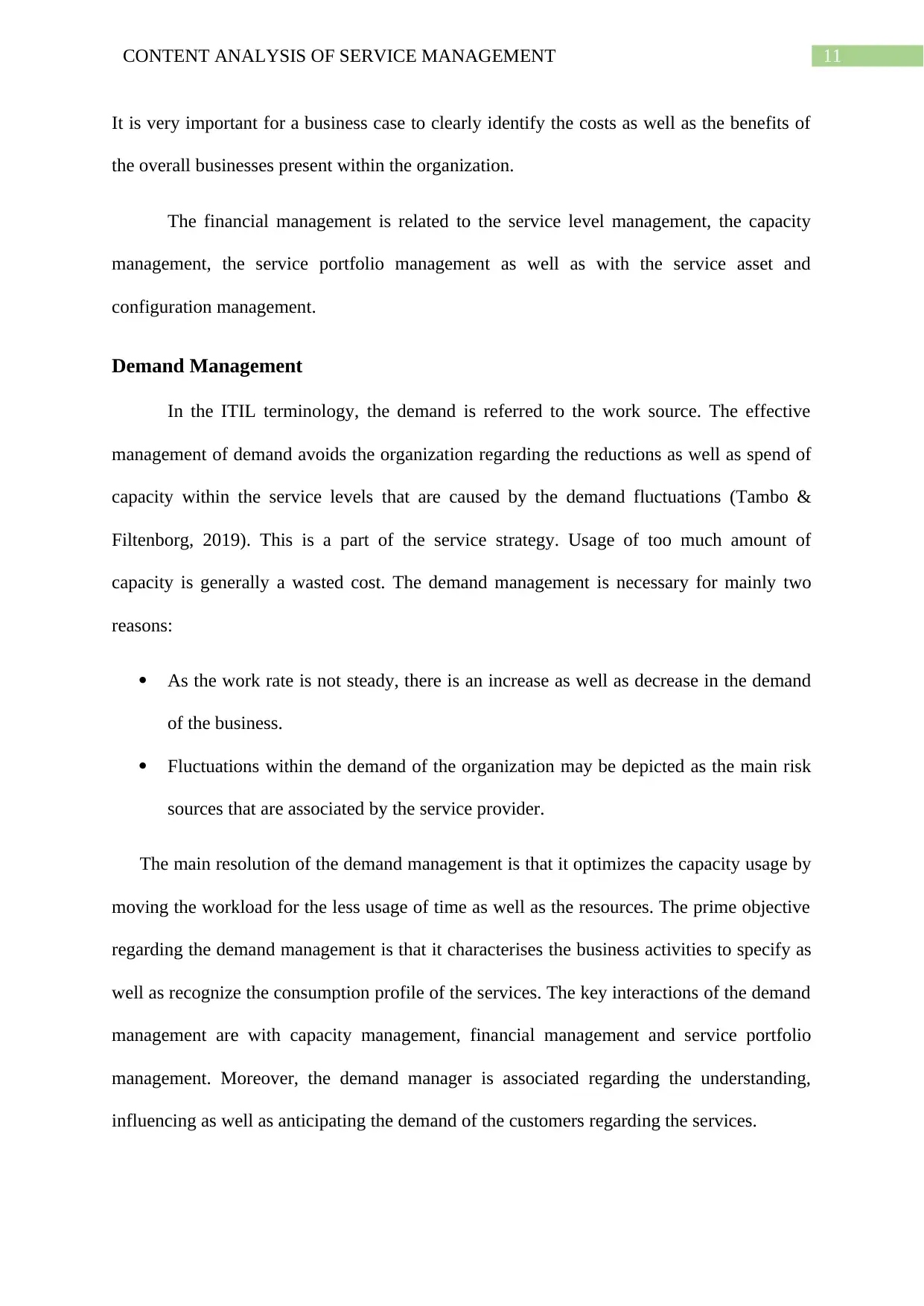
11CONTENT ANALYSIS OF SERVICE MANAGEMENT
It is very important for a business case to clearly identify the costs as well as the benefits of
the overall businesses present within the organization.
The financial management is related to the service level management, the capacity
management, the service portfolio management as well as with the service asset and
configuration management.
Demand Management
In the ITIL terminology, the demand is referred to the work source. The effective
management of demand avoids the organization regarding the reductions as well as spend of
capacity within the service levels that are caused by the demand fluctuations (Tambo &
Filtenborg, 2019). This is a part of the service strategy. Usage of too much amount of
capacity is generally a wasted cost. The demand management is necessary for mainly two
reasons:
As the work rate is not steady, there is an increase as well as decrease in the demand
of the business.
Fluctuations within the demand of the organization may be depicted as the main risk
sources that are associated by the service provider.
The main resolution of the demand management is that it optimizes the capacity usage by
moving the workload for the less usage of time as well as the resources. The prime objective
regarding the demand management is that it characterises the business activities to specify as
well as recognize the consumption profile of the services. The key interactions of the demand
management are with capacity management, financial management and service portfolio
management. Moreover, the demand manager is associated regarding the understanding,
influencing as well as anticipating the demand of the customers regarding the services.
It is very important for a business case to clearly identify the costs as well as the benefits of
the overall businesses present within the organization.
The financial management is related to the service level management, the capacity
management, the service portfolio management as well as with the service asset and
configuration management.
Demand Management
In the ITIL terminology, the demand is referred to the work source. The effective
management of demand avoids the organization regarding the reductions as well as spend of
capacity within the service levels that are caused by the demand fluctuations (Tambo &
Filtenborg, 2019). This is a part of the service strategy. Usage of too much amount of
capacity is generally a wasted cost. The demand management is necessary for mainly two
reasons:
As the work rate is not steady, there is an increase as well as decrease in the demand
of the business.
Fluctuations within the demand of the organization may be depicted as the main risk
sources that are associated by the service provider.
The main resolution of the demand management is that it optimizes the capacity usage by
moving the workload for the less usage of time as well as the resources. The prime objective
regarding the demand management is that it characterises the business activities to specify as
well as recognize the consumption profile of the services. The key interactions of the demand
management are with capacity management, financial management and service portfolio
management. Moreover, the demand manager is associated regarding the understanding,
influencing as well as anticipating the demand of the customers regarding the services.
⊘ This is a preview!⊘
Do you want full access?
Subscribe today to unlock all pages.

Trusted by 1+ million students worldwide
1 out of 20
Related Documents
Your All-in-One AI-Powered Toolkit for Academic Success.
+13062052269
info@desklib.com
Available 24*7 on WhatsApp / Email
![[object Object]](/_next/static/media/star-bottom.7253800d.svg)
Unlock your academic potential
Copyright © 2020–2025 A2Z Services. All Rights Reserved. Developed and managed by ZUCOL.




